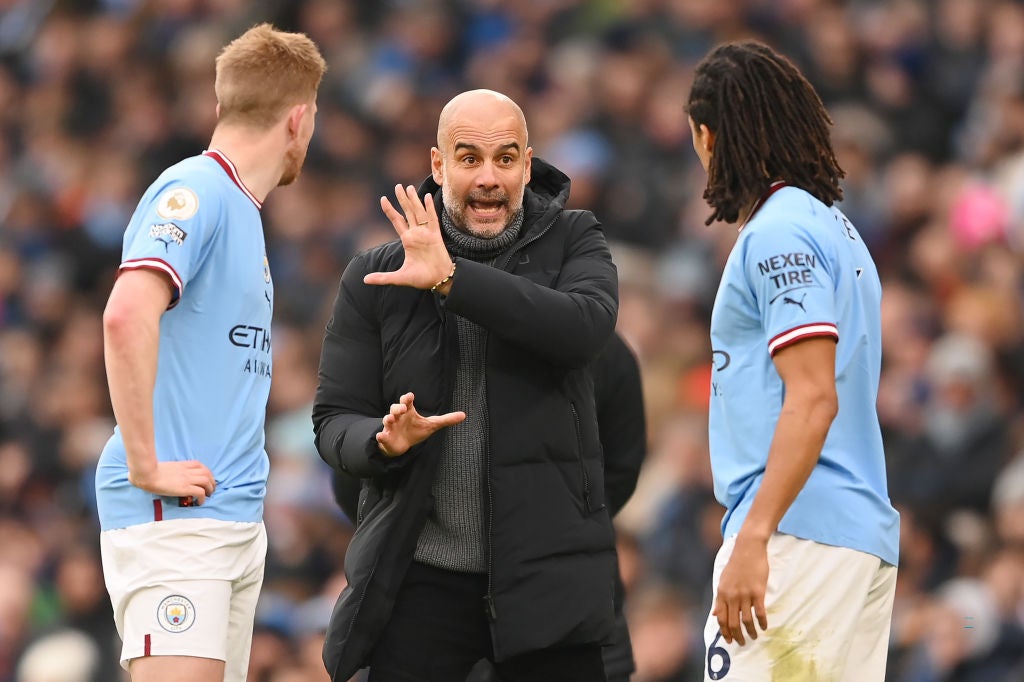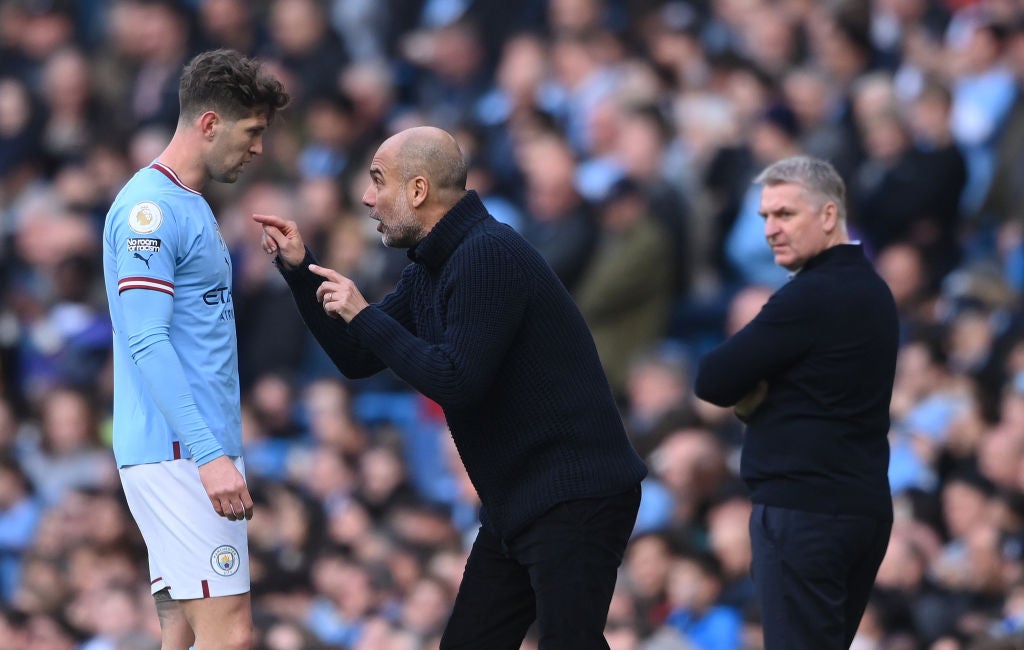Pep Guardiola’s five decisions that won Man City the Premier League
Guardiola has won his fifth Premier League in six seasons and the manager’s tactical tweaks have taken City to another level

Your support helps us to tell the story
From reproductive rights to climate change to Big Tech, The Independent is on the ground when the story is developing. Whether it's investigating the financials of Elon Musk's pro-Trump PAC or producing our latest documentary, 'The A Word', which shines a light on the American women fighting for reproductive rights, we know how important it is to parse out the facts from the messaging.
At such a critical moment in US history, we need reporters on the ground. Your donation allows us to keep sending journalists to speak to both sides of the story.
The Independent is trusted by Americans across the entire political spectrum. And unlike many other quality news outlets, we choose not to lock Americans out of our reporting and analysis with paywalls. We believe quality journalism should be available to everyone, paid for by those who can afford it.
Your support makes all the difference.Manchester City are Premier League champions once again. Pep Guardiola’s side have won their third title in a row and fifth in six seasons after winning 13 of their last 14 matches to storm to the finish line.
Arsenal held an eight-point lead in mid-January but City have been unstoppable over the second half of the season, defeating the Gunners 3-1 at the Emirates and 4-1 at the Etihad to overhaul Mikel Arteta’s side in the title race.
Erling Haaland’s record-breaking campaign has been a key part of City’s success - with the Norwegian hitting 36 goals to smash the Premier League’s single-season scoring record - but it was Guardiola’s tactical tweaks that took City’s dominance to another level during the run-in.
Despite Haaland’s immediate impact after arriving at City, there were some early doubts over how the striker was affecting their overall play as Guardiola’s side struggled to break down disciplined defensive structures. There were occasions where the champions did not look as fluid as they had been when using a striker-less system the previous year.
Guardiola, though, found the answers, and the only question now is where this City side may rank among the greatest teams of all time. With the Premier League secured and the treble firmly in sight, here are five key decisions made by Guardiola that turned his team’s season around and won City the title.
Allowing Joao Cancelo to leave on loan
The Portuguese was the best full-back in the Premier League last season and in many ways represented what Guardiola wanted from a player in that position, with an ability to come into central areas and act as a playmaker for his team from deep.
The decision, therefore, to ship Cancelo on loan to Bayern Munich midway through the season, leaving City without a recognised left-back, was as shocking as it was confusing.
But Cancelo, whose attacking output dipped dramatically following Haaland’s arrival, wanted more game time and Guardiola sanctioned his exit to send a message to his squad.
Guardiola had accused some of his players of lacking “passion, fire and desire” during his “happy flowers” rant after City came from 2-0 down to defeat Tottenham 4-2 in January.
Guardiola wanted to sharpen standards, but Cancelo’s exile also allowed the Catalan to properly commit to an evolution of City’s style that would change their season…
Moving John Stones into midfield
Signing Haaland dramatically altered how City played over the first few months of the season. Although the Norwegian was scoring goals at an astonishing rate, his position at the tip of City’s attack left Guardiola’s team without an additional player in midfield, which the manager often got through his use of a ‘false nine’ the previous year.
Guardiola demands control and defensive stability to go along with his attacking and possession-based ethos, and decided that Cancelo took too many risks with his passes from central areas that he felt City couldn’t afford given their lack of numbers.
After initially looking at Rico Lewis, a product of City’s academy perfectly engineered to play the Catalan’s inverted full-back role, Guardiola decided to move John Stones out of the backline and into midfield when his side had established possession.

Since then, Stones has been magnificent, with his exemplary pass-completion percentage, defensive instincts and physicality to deal with transitions giving Guardiola what he desperately wanted from his second ‘sitting’ midfielder in City’s 3-2-4-1 formation.
With Stones moving alongside Rodri in midfield, it has allowed Ilkay Gundogan and Kevin De Bruyne to push forward - creating a ‘box’ midfield that Guardiola learned when playing under the influential visionary Johan Cruyff at Barcelona.
Committing to centre-backs
With Haaland leading the line for City, Guardiola’s desire to have five-defensive minded players alongside five attackers has, in practice, meant five centre-backs if you include Rodri - who played there for Spain during the World Cup.
In doing so, Guardiola has asked Nathan Ake and Manuel Akanji to play out of position at full-back and take on the individual duels with opposition wingers. Both have been revelations this season, with supreme defensive abilities in 1v1 situations.
At times, Kyle Walker has been forced out of the side, with Guardiola suggesting only last month that the England right back can’t play his City’s new system.
But Walker has also been outstanding in recent weeks when fielded as one of Guardiola’s ‘centre-backs’ - particularly in individual duels against Arsenal’s Gabriel Martinelli and Real Madrid’s Vinicius Junior.
Benching Kevin De Bruyne (for a month)
“He needs to do the simple things”, Guardiola said in March as he explained why Kevin De Bruyne had gone through a spell of starting as many games on the bench as in City’s line-up.
Guardiola felt De Bruyne’s form had dipped following the World Cup so dropped the Belgian from his team - including in the 1-0 defeat at Tottenham.
The response from De Bruyne, though, was emphatic: scoring against Liverpool, twice against Arsenal, producing three assists across wins against Leicester and Southampton - and then scoring City’s crucial equaliser in the Bernabeu against Real Madrid in the Champions League.
Even with Haaland - there is no question that De Bruyne is City’s big-game player, and that comes in part from Guardiola ensuring the midfielder is always playing on the edge and delivers his best when it counts.
Changing his tactics against Arsenal
It was notable when Guardiola sacrificed his principles across both clashes with City’s title rivals, using Haaland as a target man and bypassing Arsenal’s press with direct passes to the No. 9.
City were perhaps fortunate to come away from the Emirates with a victory in the first meeting, but they were utterly dominant in the reverse clash at the Etihad - with De Bruyne running off Haaland in a devastating strike partnership.
Long balls were central to that, with Haaland winning both battles with William Saliba in the first fixture and then Rob Holding in the second, with De Bruyne thriving on the second balls in a near-reversal of what we had come to expect from Guardiola’s side.




Join our commenting forum
Join thought-provoking conversations, follow other Independent readers and see their replies
Comments